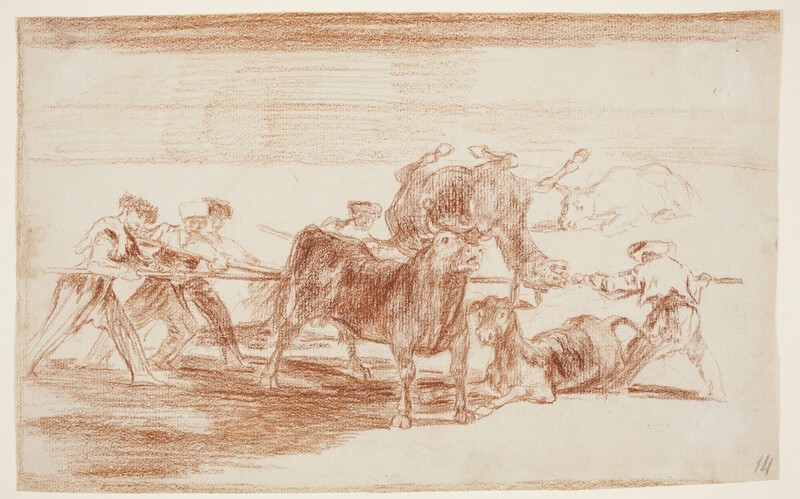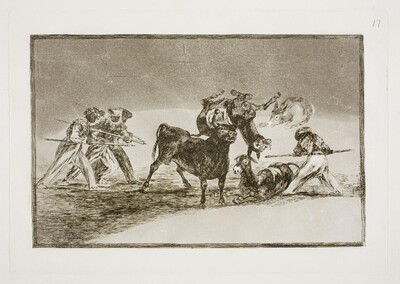- Cronología
- Ca. 1814 - 1816
- Ubicación
- The Prado National Museum. Madrid, Madrid, Spain
- Dimensiones
- 184 x 293 mm
- Técnica y soporte
- Reconocimiento de la autoría de Goya
- Documented work
- Titular
- El Prado National Museum
- Ficha: realización/revisión
- 01 Oct 2021 / 22 Jun 2023
- Inventario
- (D4302)
14 (in pencil, bottom right-hand corner)
See How the ancient Spaniards hunted bulls on horseback in the countryside.
This preparatory drawing passed by inheritance in 1828 to Javier Goya, the painter's son, and in 1854 to Mariano Goya y Goicoechea, the artist's grandson. It was subsequently owned by Valentín Carderera (ca. 1861) and Mariano Carderera (1880). In 1886 it was acquired from Mariano Carderera, along with many other drawings by Goya, including almost all the preparatory studies for the Bullfight, by the Directorate General of Public Instruction, and was assigned to the Prado Museum, where it entered on 12 November 1886.
See How the ancient Spaniards hunted bulls on horseback in the countryside.
Preparatory drawing of the print Moorish palenque made with donkeys to defend themselves from the bull. It has certain differences with the engraving, the main one being the presence of a character later eliminated in the final work.
According to Gassier, the scene is representative of the Islamic period in Spain, when combat between bull and man took place without rules. Here we see five figures dressed as Mamluks facing the bull, who is at the centre of the composition and has an upside-down donkey between his horns. To his right is another donkey lying on the ground, probably wounded, and a Moor with a pike spearing the bull. To his left is a group of three Moors who are also spearing the bull, and behind him is another Moor who will be eliminated when the drawing is transferred to the plate. Finally, in the background we find another donkey lying on the ground, probably badly wounded, in front of the barrier that delimits the bullring, which is similar to the one we will see later in the engraving, although in this case with a shallower resolution.
The study of the animals, their postures and movements, is the most interesting aspect of this preparatory drawing.
-
Goya: toros y torerosEspace Van GoghArles1990displayed also at Academia de Bellas Artes de San Fernando, Madrid, consultant editor Pierre Gassier.cat. 21
-
Madrid1990
-
Madrid2002
-
1946pp. 177-216, espec. pp. 197-198
-
MadridMuseo del Prado1954n. 169
-
ParísLe Club Français du Livre1963p. 92
-
Vie et ouvre de Francisco de GoyaParísOffice du livre1970p. 278, cat. 1185
-
Barcelona1974p. 15
-
Dibujos de Goya, 2 volsBarcelonaNoguer1975pp. 368-369, cat. 259
-
MadridMuseo Nacional del Prado2001pp. 68-70

